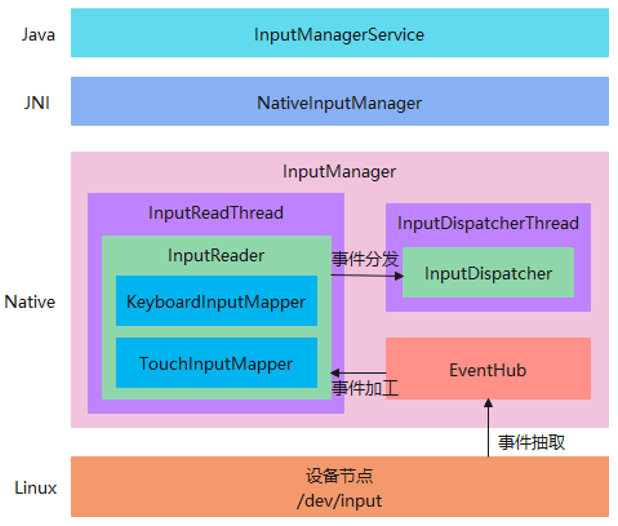1 前言
IMS 是 InputManagerService 的简称,主要负责输入事件管理。
1.1 基本概念
- 输入设备:屏幕、电源/音量、键鼠、充电口、蓝牙、wifi 等
- 设备节点:当输入设备可用时,Linux 内核会在 /dev/input 中创建对应的设备节点
- 输入事件:触摸事件、按键事件、鼠标事件、插拔事件等
- 输入子系统:负责采集 Linux 内核中输入事件原始信息,原始信息由 Kernel space 的驱动层一直传递到 User space 的设备节点
IMS 所做的工作就是监听 /dev/input 下的所有的设备节点,当设备节点有数据时,对数据进行加工处理并找到合适的 Window,将输入事件派发给它。
1.2 IMS 框架

(1)EventHub
- 监听、扫描、打开 /dev/input 目录下的输入设备
- 根据配置文件和键值映射文件对设备进行配置和键值映射
- 将所有设备添加到本地列表中
- 抽取驱动程序上报的 inputEvent,主要包含设备可用性变化事件(设备事件)、设备节点中读取的原始输入事件。
(2)InputReader
- 根据设备类型添加不同 InputMapper
- 通过 EventHub.getEvents() 获取 EventHub 中未处理的事件
(3)InputDispatcher
- 事件过滤,并发给上层。
2 Java 层 IMS 初始化流程
2.1 IMS 启动流程
(1)main
/frameworks/base/services/java/com/android/server/SystemServer.java
public static void main(String[] args) {
new SystemServer().run();
}
(2)run
/frameworks/base/services/java/com/android/server/SystemServer.java
private void run() {
try {
...
// 创建Looper
Looper.prepareMainLooper();
// 加载libandroid_servers.so
System.loadLibrary("android_servers");
// 创建系统的 Context:ContextImpl.createSystemContext(new ActivityThread())
createSystemContext();
// 创建 SystemServiceManager
mSystemServiceManager = new SystemServiceManager(mSystemContext);
LocalServices.addService(SystemServiceManager.class, mSystemServiceManager);
...
}
...
try {
//启动引导服务,ActivityManagerService、ActivityTaskManagerService、PackageManagerService、PowerManagerService、DisplayManagerService 等
startBootstrapServices();
//启动核心服务,BatteryService、UsageStatusService 等
startCoreServices();
//启动其他服务,InputManagerService、WindowManagerService、CameraService、AlarmManagerService 等
startOtherServices();
...
}
...
// 开启消息循环
Looper.loop();
}
(3)startOtherServices
/frameworks/base/services/java/com/android/server/SystemServer.java
private void startOtherServices() {
...
WindowManagerService wm = null;
...
InputManagerService inputManager = null;
...
try {
...
inputManager = new InputManagerService(context);
...
//PhoneWindowManager 是 WMP 的实现类
wm = WindowManagerService.main(context, inputManager, !mFirstBoot, mOnlyCore, new PhoneWindowManager(), mActivityManagerService.mActivityTaskManager);
ServiceManager.addService(Context.WINDOW_SERVICE, wm, false, DUMP_FLAG_PRIORITY_CRITICAL | DUMP_FLAG_PROTO);
ServiceManager.addService(Context.INPUT_SERVICE, inputManager, false, DUMP_FLAG_PRIORITY_CRITICAL);
...
mActivityManagerService.setWindowManager(wm);
...
wm.onInitReady(); //initPolicy
...
//wm 的 mInputManagerCallback 属性在定义时就被初始化
inputManager.setWindowManagerCallbacks(wm.getInputManagerCallback());
inputManager.start();
...
}
}
通过 ServiceManager.addService() 将 Context.INPUT_SERVICE 与 IMS 绑定,因此在其他进程中可以通过如下方式获取 IMS。
IBinder b = ServiceManager.getService(Context.INPUT_SERVICE);
IInputManager im = IInputManager.Stub.asInterface(b);
2.2 IMS 初始化
(1)构造方法
/frameworks/base/services/core/java/com/android/server/input/InputManagerService.java
public InputManagerService(Context context) {
this.mContext = context;
//在 android.display 线程中处理消息
this.mHandler = new InputManagerHandler(DisplayThread.get().getLooper());
...
//mPtr 为 JNI 层 NativeInputManager 对象的地址
mPtr = nativeInit(this, mContext, mHandler.getLooper().getQueue());
String doubleTouchGestureEnablePath = context.getResources().getString(R.string.config_doubleTouchGestureEnableFile);
mDoubleTouchGestureEnableFile = TextUtils.isEmpty(doubleTouchGestureEnablePath) ? null : new File(doubleTouchGestureEnablePath);
//添加本地服务
LocalServices.addService(InputManagerInternal.class, new LocalService());
}
nativeInit() 方法在 JNI 层创建了 NativeInputManager 对象,并返回其地址(后文会介绍);LocalService 是 IMS 的内部类,也是 InputManagerInternal 的实现类。
(2)setWindowManagerCallbacks
/frameworks/base/services/core/java/com/android/server/input/InputManagerService.java
public void setWindowManagerCallbacks(WindowManagerCallbacks callbacks) {
mWindowManagerCallbacks = callbacks;
}
callbacks 来自 WMS.mInputManagerCallback,属于 InputManagerCallback 类(IMS.WindowManagerCallbacks 的实现类),WMS.mInputManagerCallback 在定义时就被初始化。
(3)start
/frameworks/base/services/core/java/com/android/server/input/InputManagerService.java
public void start() {
//启动 Native 层的 InputReaderThread 和 InputDispatcherThread 线程
nativeStart(mPtr);
//注册监听器
registerPointerSpeedSettingObserver();
registerShowTouchesSettingObserver();
registerAccessibilityLargePointerSettingObserver();
mContext.registerReceiver(new BroadcastReceiver() {
@Override
public void onReceive(Context context, Intent intent) {
updatePointerSpeedFromSettings();
updateShowTouchesFromSettings();
updateAccessibilityLargePointerFromSettings();
}
}, new IntentFilter(Intent.ACTION_USER_SWITCHED), null, mHandler);
updatePointerSpeedFromSettings();
updateShowTouchesFromSettings();
updateAccessibilityLargePointerFromSettings();
}
nativeStart() 方法启动 Native 层 InputReaderThread 和 InputDispatcherThread 线程(后面会介绍)。
3 Native 层 IMS 初始化流程
本节主要介绍 IMS 构造方法中调用 nativeInit() 方法、start() 方法中调用 nativeStart() 方法的后续流程。
如图,展示了 IMS 初始化流程,浅蓝色、绿色、紫色分别表示 Java 层、JNI 层、Native 层。

3.1 nativeInit 后续流程
(1)gInputManagerMethods
/frameworks/base/services/core/jni/com_android_server_input_InputManagerService.cpp
static const JNINativeMethod gInputManagerMethods[] = {
//Java 层调用的 nativeInit 方法对应 JNI 层的 nativeInit 方法
{ "nativeInit",
"(Lcom/android/server/input/InputManagerService;Landroid/content/Context;Landroid/os/MessageQueue;)J",
(void*) nativeInit },
//Java 层调用的 nativeStart 方法对应 JNI 层的 nativeStart 方法
{ "nativeStart", "(J)V",
(void*) nativeStart },
...
}
gInputManagerMethods 数组列出了 Java 层调用 nativeInit()、nativeStart() 方法到 JNI 层具体调用方法的映射关系。
(2)nativeInit
/frameworks/base/services/core/jni/com_android_server_input_InputManagerService.cpp
//Java 层调用:mPtr = nativeInit(this, mContext, mHandler.getLooper().getQueue());
static jlong nativeInit(JNIEnv* env, jclass, jobject serviceObj, jobject contextObj, jobject messageQueueObj) {
//获取 JNI 层消息队列
sp<MessageQueue> messageQueue = android_os_MessageQueue_getMessageQueue(env, messageQueueObj);
...
//创建 NativeInputManager
NativeInputManager* im = new NativeInputManager(contextObj, serviceObj, messageQueue->getLooper());
im->incStrong(0);
//返回 NativeInputManager 对象指针给 Java 层(mPtr)
return reinterpret_cast<jlong>(im);
}
NativeInputManager 是在该文件中定义的类。
(3)NativeInputManager
/frameworks/base/services/core/jni/com_android_server_input_InputManagerService.cpp
#include <inputflinger/InputManager.h>
NativeInputManager::NativeInputManager(jobject contextObj, jobject serviceObj, const sp<Looper>& looper) :
mLooper(looper), mInteractive(true) {
JNIEnv* env = jniEnv();
mServiceObj = env->NewGlobalRef(serviceObj);
...
mInteractive = true;
//创建 Native 层 InputManager,2 个 this 分别为:InputReaderPolicyInterface、InputDispatcherPolicyInterface
mInputManager = new InputManager(this, this);
defaultServiceManager()->addService(String16("inputflinger"), mInputManager, false);
}
NativeInputManager 实现了 RefBase、InputReaderPolicyInterface、InputDispatcherPolicyInterface、PointerControllerPolicyInterface 4个接口。InputManager.h 中定义了抽象的 InputManager 类,InputManager.cpp 实现了 InputManager.h 中的抽象方法。
(4)InputManager
/frameworks/native/services/inputflinger/InputManager.h
class InputManager : public InputManagerInterface, public BnInputFlinger {
...
public:
InputManager(const sp<InputReaderPolicyInterface>& readerPolicy, const sp<InputDispatcherPolicyInterface>& dispatcherPolicy);
virtual status_t start();
...
virtual void setInputWindows(const std::vector<InputWindowInfo>& handles, const sp<ISetInputWindowsListener>& setInputWindowsListener);
virtual void transferTouchFocus(const sp<IBinder>& fromToken, const sp<IBinder>& toToken);
...
virtual void registerInputChannel(const sp<InputChannel>& channel);
private:
sp<InputReaderInterface> mReader;
sp<InputReaderThread> mReaderThread;
sp<InputClassifierInterface> mClassifier;
sp<InputDispatcherInterface> mDispatcher;
sp<InputDispatcherThread> mDispatcherThread;
void initialize();
};
注意:InputManager 继承了 BnInputFlinger 接口(Binder 跨进程通讯的服务端)。
(5)InputManager
/frameworks/native/services/inputflinger/InputManager.cpp
#include "InputManager.h"
#include "InputReaderFactory.h"
InputManager::InputManager(const sp<InputReaderPolicyInterface>& readerPolicy, const sp<InputDispatcherPolicyInterface>& dispatcherPolicy) {
//创建 InputDispatcher
mDispatcher = new InputDispatcher(dispatcherPolicy);
mClassifier = new InputClassifier(mDispatcher);
//创建 InputReader,createInputReader() 是 InputReaderFactory 类的方法
mReader = createInputReader(readerPolicy, mClassifier);
initialize();
}
(6)InputDispatcher
/frameworks/native/services/inputflinger/InputDispatcher.cpp
InputDispatcher::InputDispatcher(const sp<InputDispatcherPolicyInterface>& policy) :
mPolicy(policy), ... {
//创建消息循环
mLooper = new Looper(false);
mReporter = createInputReporter();
...
policy->getDispatcherConfiguration(&mConfig);
}
(7)createInputReader
/frameworks/native/services/inputflinger/InputReaderFactory.cpp
sp<InputReaderInterface> createInputReader(const sp<InputReaderPolicyInterface>& policy, const sp<InputListenerInterface>& listener) {
return new InputReader(new EventHub(), policy, listener);
}
注意:此处创建了 EventHub,并注入到 InputReader 中。
(8)InputReader
/frameworks/native/services/inputflinger/InputReader.cpp
InputReader::InputReader(const sp<EventHubInterface>& eventHub, const sp<InputReaderPolicyInterface>& policy, const sp<InputListenerInterface>& listener) :
mContext(this), mEventHub(eventHub), mPolicy(policy), ... {
mQueuedListener = new QueuedInputListener(listener);
...
}
(9)EventHub
/frameworks/native/services/inputflinger/EventHub.cpp
EventHub::EventHub(void) :
mBuiltInKeyboardId(NO_BUILT_IN_KEYBOARD), mNextDeviceId(1), mControllerNumbers(),
mOpeningDevices(nullptr), mClosingDevices(nullptr),
mNeedToSendFinishedDeviceScan(false),
mNeedToReopenDevices(false), mNeedToScanDevices(true),
mPendingEventCount(0), mPendingEventIndex(0), mPendingINotify(false) {
...
mEpollFd = epoll_create1(EPOLL_CLOEXEC);
...
mINotifyFd = inotify_init();
mInputWd = inotify_add_watch(mINotifyFd, DEVICE_PATH, IN_DELETE | IN_CREATE);
...
int result = epoll_ctl(mEpollFd, EPOLL_CTL_ADD, mINotifyFd, &eventItem);
...
int wakeFds[2];
result = pipe(wakeFds);
...
mWakeReadPipeFd = wakeFds[0];
mWakeWritePipeFd = wakeFds[1];
result = fcntl(mWakeReadPipeFd, F_SETFL, O_NONBLOCK);
...
result = fcntl(mWakeWritePipeFd, F_SETFL, O_NONBLOCK);
...
eventItem.data.fd = mWakeReadPipeFd;
result = epoll_ctl(mEpollFd, EPOLL_CTL_ADD, mWakeReadPipeFd, &eventItem);
...
}
(10)initialize
/frameworks/native/services/inputflinger/InputManager.cpp
void InputManager::initialize() {
mReaderThread = new InputReaderThread(mReader);
mDispatcherThread = new InputDispatcherThread(mDispatcher);
}
InputReaderThread 和 InputDispatcherThread 都继承了 Thread 类。
在 InputManager.h 文件中,已申明 InputReaderThread 和 InputDispatcherThread 的源码不再开源,如下。
/*
* By design, the InputReaderThread class and InputDispatcherThread class do not share any
*/
3.2 nativeStart 后续流程
(1)nativeStart
/frameworks/base/services/core/jni/com_android_server_input_InputManagerService.cpp
static void nativeStart(JNIEnv* env, jclass, jlong ptr) {
//通过对象地址获取 NativeInputManager 对象指针
NativeInputManager* im = reinterpret_cast<NativeInputManager*>(ptr);
//调用 Native 层 InputManager 的 start() 方法
status_t result = im->getInputManager()->start();
...
}
inline sp<InputManager> getInputManager() const {
return mInputManager;
}
(2)start
/frameworks/native/services/inputflinger/InputManager.cpp
status_t InputManager::start() {
//开启 DispatcherThread 线程
status_t result = mDispatcherThread->run("InputDispatcher", PRIORITY_URGENT_DISPLAY);
...
//开启 ReaderThread 线程
result = mReaderThread->run("InputReader", PRIORITY_URGENT_DISPLAY);
...
return OK;
}
声明:本文转自【framework】IMS启动流程
标签:...,const,frameworks,流程,sp,framework,IMS,InputManager,new From: https://www.cnblogs.com/zhyan8/p/17233655.html